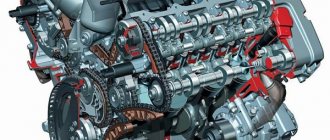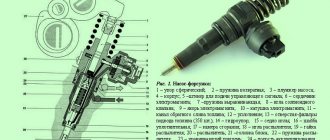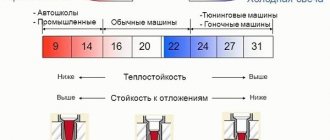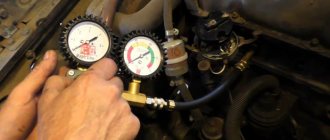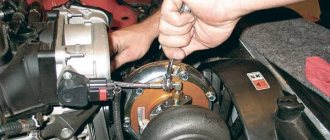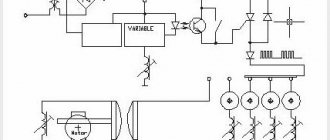Diesel engine compression measurement
Measuring the compression of a diesel or gasoline engine as a process is a series of simple operations during which the percentage of air compression by a piston is measured.
Based on the test results, conclusions are drawn about the condition of the piston group, cylinder, gaskets, and head of this block. For measurements, a special device is used - a compression meter or compressograph. The difference between them is only one thing: the first one measures in real time and the results are not saved anywhere, unlike the second option, when the readings are immediately recorded on electronic or paper media, which greatly simplifies the process if the measurements are taken by one person.
Checking the compression of a diesel engine and a gasoline engine is slightly different. Those aspects that are not important when measuring on a gasoline engine greatly affect a diesel engine. This is why problems often arise when checking compression by an inexperienced technician who does not yet know that such aspects exist.
How is verification carried out?
compressograph
Diesel compression is the main indicator that allows you to determine the condition of the most important components of the engine system. To identify the condition, each engine has optimal compression indicators compiled taking into account its main features. If during the test a drop in engine compression was detected, this is a strong argument for professional diagnostics of your car. In such a situation, you may need high-quality repairs to restore the function of the car. Therefore, it is necessary to understand how to determine compression readings in the engine. For a successful check, it is necessary to take into account certain subtleties during the work.
Let's look at the relatively simple but really important rules that compression testing requires:
- Determining compression on a diesel engine, possibly through the spark plug channels.
- Compression can be detected by maintaining the thermal characteristics of the engine. It will not be possible to check the compression of a diesel engine with insufficient heating, since the indicators will be underestimated due to insufficient expansion of the working fluid.
- Real test results can only be obtained with the throttle fully open. If the damper is not fully open, the readings will be incorrect.
- Before checking, you must make sure that the starter is in full working order and the battery is properly charged.
- The check involves completely removing the glow plugs from each working cylinder.
To carry out this operation, you will need one of the two above-mentioned devices (compressometer or compressograph). A compression gauge looks a little different from a pressure gauge. To check, you need to remove the spark plugs and install the device conductors in their position. Next, you need to fully open the throttle and turn the key in the ignition. After the starter turns the crankshaft a couple of times, you need to pay attention to the readings of the measuring device. So, it is necessary to check each cylinder. By checking each cylinder, you can determine the general condition of the CPG. If the compression is normal, then your engine is in completely good condition. In the event of a slight change in compression, you can try to restore engine function using special additives. In case of a significant deviation from the norm, you need to contact professionals; your engine may need to be given due attention.
Thus, we learned how to check the compression in the engine. It is necessary to understand that this parameter is fundamental for a diesel engine. Therefore, to maintain the engine in good condition, check it at least once a month. Good luck with your test results!
Theory
In order to avoid such errors, it is worth getting acquainted with the theory. In addition to compression in the cylinders, there is also another value called the compression ratio. The compression ratio is just a geometric value that reflects the relationship of the combustion chamber between the head and the piston at its positions at top and bottom dead center.
Usually this value is stable and cannot change during normal operation of the engine. It can be changed by boring the engine or, conversely, installing a thicker gasket. It is worth noting that this value is greater than that of gasoline engines.
So it turns out that most often these two concepts are confused, although compression is a physical quantity, measured in kilograms per square centimeter, pci or bars and, in fact, is the pressure that is created in the engine cylinders when the piston operates. The compression amount is always greater than the compression ratio.
This arises accordingly as a result of the action of physics. As the piston passes through the cylinder, friction occurs, which results in heating. And it turns out that this same energy is given not to the metal, but to the air that is in the cylinder. The air increases in volume, the pressure increases, so the compression ratio will always be less than the compression on a diesel engine, and on a gasoline engine too.
Compression in a diesel engine
February 27, 2021 Category: Useful information.
Compression is one of the main performance characteristics of not only diesel, but also gasoline power units. It represents the pressure generated in the cylinder when the piston reaches its highest position.
In the article:
Compression is often confused with compression ratio, but these are two different parameters. The first of them characterizes pressure, the second - volume (or rather, its decrease after moving the piston from the lower to the upper position). Accordingly, compression is expressed in MPa, atmospheres, kg/cm2 or other pressure units. As for the compression ratio, it is a mathematical value expressed as the ratio of the volume of the cylinder to the volume of its combustion chamber.
What should the compression be in a diesel engine?
For normal operation of a diesel power unit, the compression in all its cylinders must correspond to the indicator set by the manufacturer.
The value may depend on the specific unit, but in any case - no less than 22 kg/cm2. Otherwise, the diesel engine will not start because the pressure in the cylinders will not be enough to turn the crankshaft.
Compression measuring device
Of course, to perform these measurements there will be a necessary tool, in this case it is a simple device that mainly consists of a barometer.
A similar barometer is also used in compressors, for inflating tire pressure, or in individual devices called the same name, barometers. But one caveat should be made: the compression gauge is designed for higher pressure.
A compression gauge is a simple design that basically consists of a pressure gauge. It, in turn, is connected to an adapter, which has the same thread bored as on a standard spark plug and has a similar appearance.
It was also said above that there is another device called a compressograph. The differences, as mentioned, are minimal, but the price advantage still remains with the first option. Although convenience can offset material costs.
Also, the price depends on many other factors that are also worth paying attention to. And the first and probably the most important factor is quality. Yes, even the cheapest product can be of high quality, but it is better to take something in the middle price category. And preferably from a trusted brand manufacturer.
The process of measuring compression using the example of a diesel engine
How to measure the compression of a diesel engine? A question to which, having studied the basics of the theory, you can move on. Measuring the compression of a diesel engine will be carried out in several main stages, but first you need to take into account some aspects:
How to check compression in a diesel engine? Let's consider all the stages of compression measurement:
Source
Compression gauge for diesel engines - why is it necessary?
Why is the compression of a diesel engine measured? There are two reasons:
Compression is measured on both gasoline and diesel engines, but fewer requirements and attention are paid to the indicators obtained for a gasoline engine; some shortcomings in the numbers are not paid attention to, because such engines have their own nuances that do not affect the “heart rate.” » car health. But for diesel engines, these nuances become significant, so this process is carried out more often and more thoroughly, and any deviation from the norm allows us to talk about problems in the main mechanism of the car. The very concept of compression, on the one hand, means a physical quantity, and not a process or phenomenon, and characterizes the level of pressure created in the cylinders. The standard condition is that the power is off (only the starter is running). On the other hand, it is considered an indicator of the maximum pressure that the air reaches in the combustion chamber, approaching the upper critical point, called the “dead” point.
Measuring the compression of a diesel engine - how to do it yourself?
So how do you measure the compression of a diesel engine? To do this, you must comply with simple conditions:
The compression of a diesel engine is measured with the cut-off lever pressed down and the solenoid valve responsible for stopping the fuel supply, which is located on the line, de-energized. The compression gauge is connected to the nozzle hole. It should be remembered that for this purpose they use a device designed for measuring compression of a diesel engine with a measurement limit of at least 60 atmospheres. In what cases is information required about what compression is in a diesel engine? Most often, the need for measurements arises in the event of poor engine starting, which indicates a significant decrease in compression. As a result, the engine begins to smoke, vibration and oil leaks appear, since due to wear of the piston group there is an intensive breakthrough of gases into the engine crankcase. The cylinder mirror is most often subject to the greatest wear.
How to determine the pressure in diesel cylinders
To organize the procedure, you will need to prepare a well-charged battery and a compression gauge for working with diesel engines (it has special attachments and a measurement limit of up to 60-70 atmospheres). Engine compression is measured after it has warmed up. Following actions:
- remove the glow plug;
- screw the compression gauge into the vacated hole;
- turn off the diesel fuel supply (remove the power plug from the solenoid valve);
- ask a friend to press the accelerator (if the diesel engine has a valve that creates a vacuum used in the vacuum brake booster and regulator) and turn on the starter with the “start” button;
- remember (write down) the data obtained using the device;
- check the obtained values with those recommended by the car manufacturer (the necessary information is in the service book).
We recommend: How to properly operate a diesel engine in winter?
The compression value in a diesel engine depends on the brand of engine and is in the range of 28-40 kg/sq.m. see. An interesting dependence of compression in a diesel engine on the possibility of starting it at a certain outside temperature. Below are the compression values when the engine starts without problems:
- up to 28 kg/sq. cm: air temperature not lower than minus 15 degrees;
- up to 30 kg/sq. cm: normal start at minus 20;
- up to 32 kg/sq. cm: the engine will start at minus 25;
- up to 36 kg/sq. cm: start-up can be done at minus 30;
- up to 40 kg/sq. cm: diesel is able to start at 35 degrees below zero.
A drop in compression in diesel engines is accompanied by the appearance of a bluish exhaust from the muffler pipe, which is associated with incomplete combustion of fuel due to low temperature. Another consequence of a decrease in pressure in the cylinders is poor atomization of diesel fuel in the chambers, leading to a drop in power of the power unit.
Engine compression test
Measuring engine compression is the most common way to assess the current state of the CPG. Measuring engine compression (compression pressure in a cylinder) allows you to find out the “real” pressure in each engine cylinder and compare these values with the nominal (factory) parameters, as well as calculate the “sick” cylinder (the values in which are very different from the rest). In this way, a malfunction in the cylinder is detected, then the diagnosis is continued using specialized diagnostic equipment.
Choosing a tester for measuring compression
To measure engine compression, a diagnostic device is used - a compression meter . There are even more expensive testers - compressographs. This is the same compression meter, only with the ability to graphically record parameters for measuring compression by cylinder.
On many gasoline cars you can measure the compression yourself. For this purpose, it is enough to buy a simple compression tester for 500-800 rubles, such as DRUG or MEASURIT (it is usually enough for 2-3 engine diagnostics). Higher quality models cost from 2000 rubles.
Advice: choose a device with a threaded tip, i.e. so that it is screwed into the spark plug hole, and not pressed into it. Then the compression measurement will be more accurate and can be done alone. Also check that the compression gauge pressure release valve is located in the threaded end that screws into the spark plug hole, and not under the pressure gauge. This way you will avoid underestimating compression values when measuring.
For owners of diesel cars, it is better to contact a car service center, because... dismantling an injector or glow plug requires special skills and tools, and you will also need a compression gauge with a special adapter for attaching it to the injector or spark plug hole. Although the TU-15A diesel compression meter is purchased from us specifically for a personal car, it is convenient for them to measure compression through the holes for glow plugs. The main thing before buying a diesel compression tester is to decide what exactly you will use to take measurements: a glow plug or an injector, so that the device you buy has just such an adapter, otherwise the purchase will be in vain.
How and what to measure
Compressometer
Compression is measured with a special device - a compression meter. It is a pressure gauge with a hose, at the end of which there is a fitting, either metal with a thread for a spark plug hole, or rubber in the form of a cone.
The process of measuring compression using a compression gauge involves placing a fitting in the spark plug hole and cranking the crankshaft with the starter until maximum pressure is reached.
Compression in a cylinder can also not be measured, but checked and compared with other cylinders.
To do this, unscrew all the spark plugs except one, and manually (using a wrench on the generator pulley nut) turn the crankshaft until the piston reaches top dead center.
Then they check the second cylinder, the third and the fourth in the same way, and compare the applied forces. Of course, this method is not comparable to measuring with a compression gauge, but it can help to understand which cylinder has a problem.
What should the compression be in VAZ cars?
The average compression rate for unboosted VAZ engines is 8-9 atmospheres, for forced ones with a reduced combustion chamber - 11-13 atmospheres.
In order to accurately determine the standard compression ratio, use the table that indicates the compression ratio in the cylinders of eight- and sixteen-valve VAZ engines.
| Number of valves | 16 | 16 | 8 | |
| Engine volume, l | 1,5 | 1,6 | 1,5 | 1,6 |
| Cylinder diameter/piston stroke, mm | 82/71 | 82/75,6 | 82/71 | 82/75,6 |
| Compression ratio | 10,5 | 10,3 | 9,9 | 9,6 |
Rules for measuring compression
Measure engine compression following the following rules: - the engine must be “warm” (60-70 degrees for the oil to have “working” fluidity). Usually the engine is “warmed up” until the cooling fan first operates, and then they immediately begin to measure compression; — the fuel supply should be turned off. You can, for example, turn off the fuel pump, injectors, or use other methods to prevent large amounts of fuel from entering the cylinders (so that the oil wedge does not wash out and the pressure in the cylinder is not underestimated); — it is necessary to remove the spark plugs from all cylinders. Selective removal of spark plugs is unacceptable, as it increases the resistance to rotation and arbitrarily reduces the speed when the engine is cranked by the starter; — the battery must be fully charged and the starter must be in good working order. Sometimes compression measurement is carried out using a charging device. This increases the accuracy of parameter measurement, because Compression measurements in all cylinders occur at the same crankshaft speed. A discharged battery will not allow you to accurately measure compression.
HOW TO CORRECTLY MEASURE COMPRESSION
Compression measurements are carried out both with the throttle valve open and closed (without touching or fully squeezing the gas pedal). Moreover, each method gives its own results and allows you to identify its own defects.
Measuring engine compression with the throttle valve closed
When the damper is closed, less air enters the cylinders, so the measured pressure will be low and will be about 11-13 bar (kg/cm2) for AI-95. Air leaks in this case are comparable to its entry into the cylinder. As a result, the measured parameter becomes especially sensitive to leaks - even with small leaks, its value drops several times.
This value allows us to draw conclusions or assumptions about the following engine defects: leakage of the valve-seat pair; valve freezing, for example, due to improper assembly of the mechanism with hydraulic pushers; defects in the camshaft cam profile in designs with hydraulic lifters, including uneven wear or runout of the back side of the cam; lack of tightness due to burnout of the head gasket or a crack in the wall of the combustion chamber.
Measuring engine compression with the throttle open
When measuring pressure with the damper open, the picture will be different. A large amount of incoming air and an increase in pressure in the cylinder, of course, contribute to an increase in leaks. However, they are obviously less than the air supply. As a result, the compression does not drop so significantly, to approximately 12-14 atm (bar). Therefore, measuring compression with an open valve is better suited for determining more “severe” engine defects, such as piston breakage and burnout, breakage or sticking (coking) of rings in the piston grooves, deformation or burnout of the valve, serious damage (scuffing) to the cylinder surface.
In both diagnostic methods, it is advisable to take into account the dynamics of pressure growth - this will help to establish the true nature of the malfunction with greater probability. So, if on the first stroke the compression value measured by a compression meter is low (4-5 atm), and during subsequent strokes it increases sharply, this indirectly indicates wear of the piston rings.
Engine compression: what is it and what is it used for?
Compression, in simple terms, is the pressure generated at the highest point of movement of the crankshaft during the compression stroke. Factors influencing changes in the compression ratio can tell a lot about the condition of the engine, its level of wear and possible problems that affect its normal functioning and the behavior of the car as a whole.
Measuring engine compression using instruments
Such factors include timing defects, wear of the piston group, coking of parts and many others. Deterioration of the technical parameters of the power unit, a sharp jump in fuel consumption - all these are the consequences of changing the compression value up or down, regardless of what specific reasons were the impetus for this.
Pressure is measured in atmospheres. Some pressure gauges use other units of measurement - bar, Megapascal.
Factors affecting internal combustion engine compression
The compression level directly depends on the volume of incoming air flow, which, in turn, depends on the problems and defects listed above. Separately, it is worth mentioning the throttle valve, which has a significant impact on compression in the cylinders: its position is regulated by air flow. Its intensity, in turn, depends on the air filter: drivers often forget to clean and change it when it gets dirty, which leads to a deterioration in its capacity.
A dirty air filter reduces engine compression
We recommend: Replacing valve guides on VAZ 2106 and 2109 cars
Compression values can vary greatly depending on the set gas distribution phases: if errors are made during their installation, the closing moment of the intake valve changes, which moves the cylinder in a certain direction.
The compression ratio can vary depending on the width of the clearances in the valve actuator. For example, the pressure may decrease if the gap is too small, causing the closing of the intake valves to be delayed. At the same time, valve overlap increases - the angle at which the valves open at the same time. This also has a negative impact on compression levels.
Due to the low temperature of the internal combustion engine, the air flow entering a cold engine does not have time to expand and warm up sufficiently, without subsequently creating the required pressure - accordingly, the compression value of the cylinders also drops.
One of the reasons for reduced compression is valve clearances
The presence of valve clearances leads to air leaks. Their intensity is influenced by certain factors that have a similar effect on the amount of compression:
- Motor temperature. As it increases, compression also increases, since the distance between the parts decreases;
- Engine oil supply. A tighter fit of the engine's rubbing parts to each other is ensured by an oil layer on their surface, which also makes it possible to reduce gaps and reduce air leaks through them;
- Fuel supply. The oil film formed on the inner surface of the cylinders when fuel drops enter is quickly washed away, which can stall the operation of the entire internal combustion engine, increases friction and reduces the density of contact of surfaces to each other;
- Depressurization of pressure gauge hoses, check valve, high force applied by springs;
- Increase in crankshaft speed.
What does engine compression affect?
The engine compression level affects various processes and engine parameters:
- Completeness of fuel combustion;
- Engine oil consumption;
- Ease of starting the engine. A decrease in pressure below normal makes it much more difficult to start the engine, especially in the cold season;
- Correct operation of the cylinders. Low compression can increase the risk of engine stalling;
- Power. The lower the compression, the lower the power.
